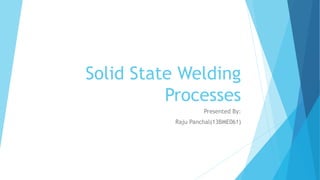
Solid state welding
- 1. Solid State Welding Processes Presented By: Raju Panchal(13BME061)
- 2. Introduction It is a welding process, in which two work pieces are joined under a pressure providing an intimate contact between them and at a temp. essentially below the melting point of the parent material. Bonding is a result of diffusion of the interface atoms.
- 4. Solid State Welding Processes • Diffusion welding • Explosion welding • Friction welding • Friction- stir welding • Forge welding • Cold welding • Roll welding • Hot pressure welding • Ultrasonic welding, etc.
- 5. Explosion Welding Explosion welding was developed relatively recently, decades after world war-II. This process is most commonly utilized to clad carbon steel with the corrosion-resistant material e.g. stainless steel, nickel alloy, titanium, zirconium, etc. SSW process in which rapid coalescence of two metallic surfaces is caused by the energy of a detonated explosive. The process is quite dangerous and should be performed under some experts in specially designed chambers.
- 7. Advantages and Disadvantages ADVANTAGES Dissimilar material joining is possible through this process. E.g., Al to steel, Cu to steel, Tungsten to steel, etc. No filler metal used. No external heat applied. Bonding is metallurgical, combined with mechanical interlocking that results from a rippled or wavy interface between the metals. DISADVANTAGES Brittle materials( Low impact toughness) can not be welded. Extensive knowledge of explosives is needed before the procedure may be attempted safely. The geometries must be simple. APPLICATIONS Joining of pipes and tubes Attaching cooling fins Major app. In pressure vessels
- 8. Friction Welding SSW process in which coalescence is achieved by frictional heat combined with pressure. 1) Rotating part, no contact 2) Parts brought into contact to generate friction heat 3) Rotation stopped and axial pressure applied 4) Weld created
- 9. Advantages and Disadvantages ADVANTAGES Process yields a narrow HAZ Can be used to join dissimilar metals APPLICATIONS Shaft and Tubular parts DISADVANTAGES At least one of the parts must be rotational. Flash must be removed (extra operation) Upsetting reduces the part lengths (which must be taken into consideration in product design)
- 10. Friction Stir Welding (FSW) SSW process in which a rotating tool is fed along a joint line between two work-pieces, generating friction heat and mechanically stirring the metal to form the weld seam Distinguished from FRW because heat is generated by a separate wear- resistant tool rather than the parts Butt joints in large aluminium parts in aerospace, automotive, and shipbuilding
- 12. Advantages and Disadvantages of Friction Stir Welding Advantages Good mechanical properties of weld joint Avoids toxic fumes, warping, and shielding issues Little distortion or shrinkage Non-consumable tool Disadvantages Keyhole at the end of each weld Heavy duty clamping of parts is required Backing bar required.
- 13. Diffusion Welding (DFW) SSW process uses heat and pressure, usually in a controlled atmosphere, with sufficient time for diffusion and coalescence to occur • Temperatures 0.5 Tm • The process is often conducted in vacuum in order to keep the bonded surfaces clean from oxides and air contaminations. • Plastic deformation at surfaces is minimal
- 14. DFW Applications • Joining of high-strength and refractory metals in aerospace and nuclear industries • Can be used to join either similar and dissimilar metals • For joining dissimilar metals, a filler layer of different metal is often sandwiched between base metals to promote diffusion • DISADVANTES • Relatively high initial investment in equipment • The mating surfaces must be precisely fitted to each other. • The surface preparation is required prior to welding process. • Time consuming process with low productivity